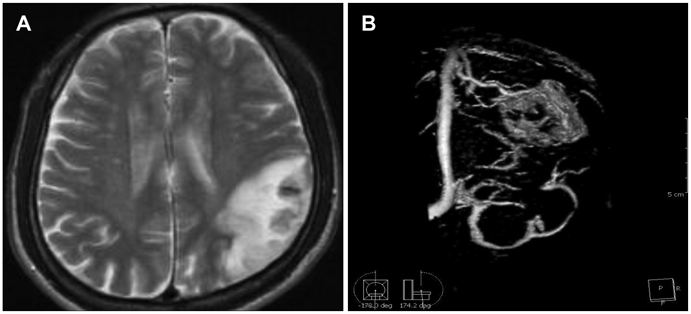J Clin Neurol.
2009 Dec;5(4):195-197. 10.3988/jcn.2009.5.4.195.
A Case of Cerebral Venous Thrombosis as the Presenting Sign of Occult Prostate Cancer
- Affiliations
-
- 1Department of Neurology, Chungbuk National University College of Medicine, Cheongju, Korea. sslee@chungbuk.ac.kr
- KMID: 2287650
- DOI: http://doi.org/10.3988/jcn.2009.5.4.195
Abstract
- BACKGROUND
Cerebral venous thrombosis (CVT) is a distinct disorder with highly variable symptoms and courses. Malignancy is known to be one of the predisposing factors of CVT. CASE REPORT: We present the case of a 69-year-old man with sudden behavioral changes. Brain MRI, magnetic resonance venography, and positive D-dimer assay confirmed the presence of CVT. The work-up for detecting the cause of the CVT revealed occult prostate cancer. CONCLUSIONS: Occult malignancy including prostate cancer should be strongly suspected in older patients with idiopathic CVT.
Keyword
MeSH Terms
Figure
Cited by 1 articles
-
Efficiency of decompressive craniectomy as a line of management of severe cerebral venous thrombosis
Mohamed M Elsherbini, Hatem Badr, Amr Farid Khalil
J Cerebrovasc Endovasc Neurosurg. 2022;24(2):129-136. doi: 10.7461/jcen.2022.E2021.07.012.
Reference
-
1. Stam J. Thrombosis of the cerebral veins and sinuses. N Engl J Med. 2005. 352:1791–1798.
Article2. Bousser MG, Ferro JM. Cerebral venous thrombosis: an update. Lancet Neurol. 2007. 6:162–170.
Article3. Khorana A, Fine R. Pancreatic cancer and thromboembolic disease. Lancet Oncol. 2004. 5:655–663.
Article4. Zhang Y, Deng Y, Luther T, Müller M, Ziegler R, Waldherr R, et al. Tissue factor controls the balance of angiogenic and antiangiogenic properties of tumor cells in mice. J Clin Invest. 1994. 94:1320–1327.
Article5. Oefelein MG, Brant M, Crotty K. Idiopathic thromboembolism as the presenting sign of occult prostate cancer. Urology. 1998. 51:775–780.
Article6. White RH, Chew HK, Zhou H, Parikh-Patel A, Harris D, Harvey D, et al. Incidence of venous thromboembolism in the year before the diagnosis of cancer in 528,693 adults. Arch Intern Med. 2005. 165:1782–1787.
Article7. Hettiarachchi RJ, Lok J, Prins MH, Büller HR, Prandoni P. Undiagnosed malignancy in patients with deep vein thrombosis: incidence, risk indicators, and diagnosis. Cancer. 1998. 83:180–185.
Article8. Cornuz J, Pearson SD, Creager MA, Cook EF, Goldman L. Importance of findings on the initial evaluation for cancer in patients with symptomatic idiopathic deep venous thrombosis. Ann Intern Med. 1996. 125:785–793.
Article9. Tardy B, Tardy-Poncet B, Viallon A, Piot M, Garnier P, Mohamedi R, et al. D-dimer levels in patients with suspected acute cerebral venous thrombosis. Am J Med. 2002. 113:238–241.
Article10. Ferro JM, Canhão P, Bousser MG, Barinagarrementeria F. ISCVT Investigators. Cerebral vein and dural sinus thrombosis in elderly patients. Stroke. 2005. 36:1927–1932.
Article
- Full Text Links
- Actions
-
Cited
- CITED
-
- Close
- Share
- Similar articles
-
- A Case of Leptomeningeal Metastasis Associated with Cerebral Venous Thrombosis
- A Case of Cerebral Venous Thromobosis Associated with Postsplenectomy Thrombocytosis
- A Case of Membranous Glomerulonephritis Presenting with Right Common Iliac Artery Thrombosis as the Initial Sign
- Cerebral Venous Sinus Thrombosis: A Case Report
- Cerebral Venous Thrombosis Presenting as Isolated Subarachnoid Hemorrhage


